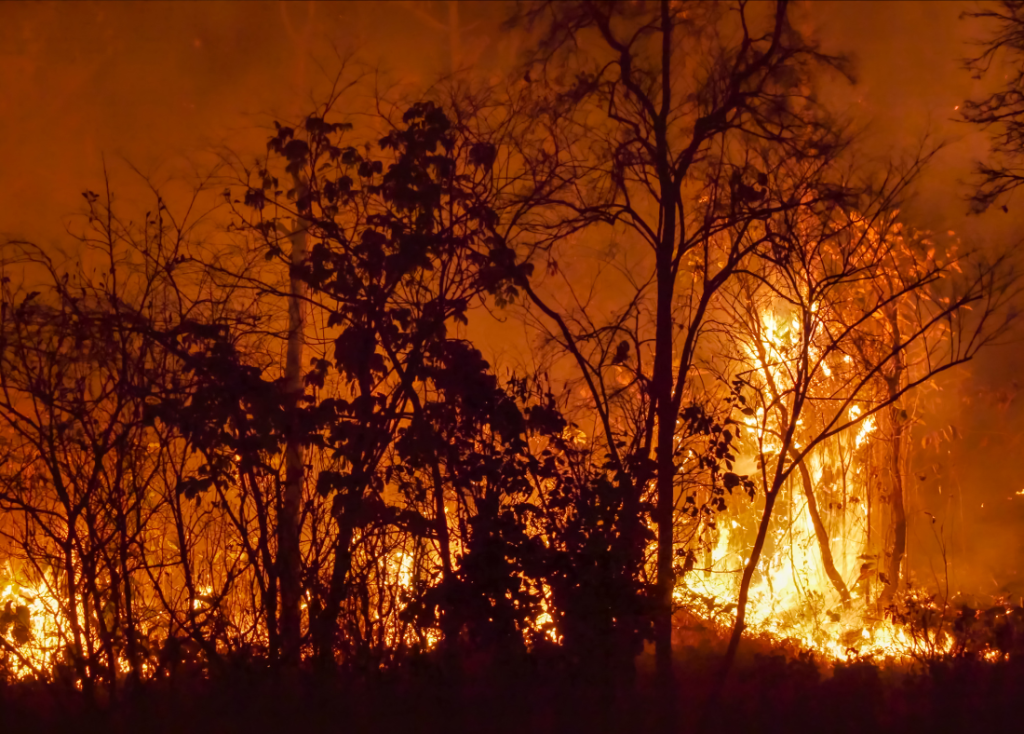By Brad Barham, SD350 Member

In California, the swings of climate change (more frequent droughts, floods, and extreme heat days) are accelerating the frequency and severity of wildfires. 15 of the 20 largest wildfires in California history have occurred since 2000, with 10 of California’s most costly and destructive fires to life and property happening after 2015. The Palisades and Eaton fires of 2025, among the largest in US history, resulted in total economic losses of ~$52.5 billion, with more than 10,000 homes destroyed.
California is not alone. Wildfire risk associated with climate change is a serious problem across the Western US. Although about half of the homes at high risk in the Western US are in California, Colorado and Texas have about half as many homes as California at high risk.
More subtle is the growing risk of wildfire conflagration where fire spreads from structure to structure after moving beyond vegetation to the built environment. Four of the worst fires in US history (the 2025 Palisades and Eaton fires, the 2023 Lahaina fire, and the 2021 Marshall fire) were conflagrations.
Not surprisingly, more severe and frequent wildfires negatively affect housing access and affordability in California and elsewhere, with the impacts reaching well beyond those directly affected by the fires. It is worth a deeper look to better understand the effects of wildfire on buying houses and being housed in an era of accelerating climate change risks.
Wildfires roil insurance markets making access, cost, and adequate coverage problematic
California homeowners and aspiring homeowners confront three major challenges in insurance markets: i.) companies withdrawing from provision of insurance especially to homes with high wildfire risk; ii.) rising home insurance rates, and, iii.) underinsured payouts following wildfire damage.
Non-renewal of home insurance is surging across western states for homeowners in high-risk wildfire zones. In California, more homeowners are securing insurance from the state through its FAIR insurance program, the provider of last resort for homeowners denied private coverage. Between 2020 and 2024, the number doubled and now accounts for about 4% of the total California residential insurance market. However, in high-risk wildfire areas FAIR Plan covers more than 20% of homeowners, and this share is rising.
Shrinkage in home insurance access in high-fire risk areas has spread across the western US. In Colorado, several of the state’s largest carriers are writing fewer policies or declining coverage in foothill communities such as Evergreen and Boulder, while average premiums have soared nearly 60% in five years. Oregon faces a similar squeeze, especially in central, southern, and eastern counties, which is forcing homeowners to hunt for last-resort coverage or pay quadrupled premiums.
Rising home insurance rates are serious, but they are not the biggest problem…
While California home insurance rates have risen rapidly in the past three years (around 25% in 2025 alone), home insurance rates in absolute terms and as a percentage of total housing costs are lower in California than nationally where other weather-related events like hurricanes, tornadoes, and flooding often make insurance rates even higher.
Underinsurance – a huge problem in the wake of the Palisades and Eaton fires
When a home burns, and insurance companies agree to a payout, it is frequently well below the replacement value of the home. Part of the problem is the ‘caps’ on dwellings built into the insurance package, while the other part is the high and rising costs of construction. Together, these help to create a large gap (often $100,000s) between the insurance payment and the actual replacement costs.
Evidence is seen in Altadena, whereby late May only 15 permits for rebuilding had been issued despite nearly 7,000 home losses. More evidence is the 2025 rise in mortgage payment delinquencies that occurred in LA following the fires as homeowners faced continuing mortgage payments on destroyed homes with little movement in replacing those homes.
In sum, rising wildfire risk in CA and the Western US is making it harder to secure adequate home insurance at reasonable costs that make payments sufficient to cover replacement costs of destroyed homes. These three outcomes negatively affecting the way housing markets work, the replacement of destroyed homes, and hence the overall supply of housing. In an era of affordable housing shortages, rising wildfire risks mean that more people will be unable to afford homes, housing, or rents. We will unpack these impacts on the poor, young people, and other vulnerable populations further in the second blog.
